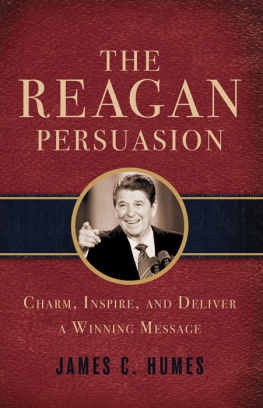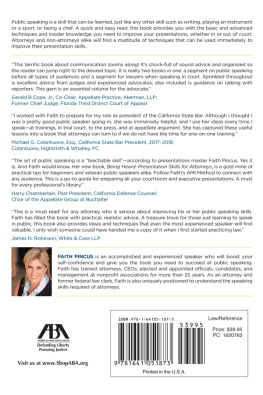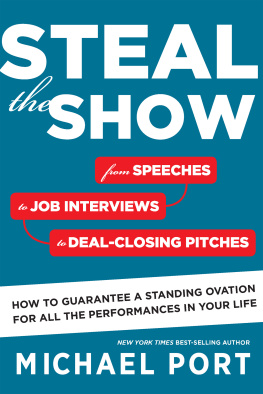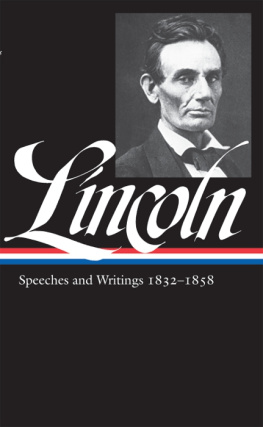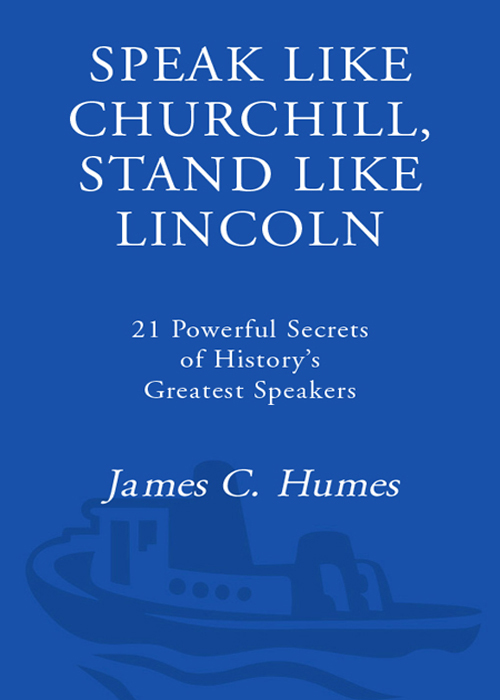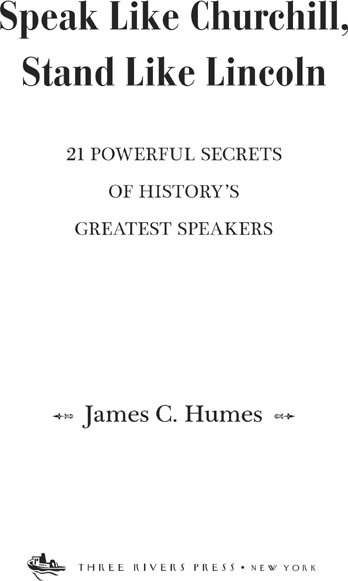As the Ryals Professor of Language and Leadership, I would like to thank Mary Jo and Jarvis Ryals for their vision and support in bringing the secrets of leadership communication to the students of the University of Southern Colorado.
I am also indebted to Dr. Rex Fuller, the dean of the Hasan School, for his administrative initiative and ideas.
Of course, without the maneuverings of one of my oldest friends, Dr. H. R. (Dick) Eisenbeis, I would have never come to U.S.C.
Always a generator of new suggestions and ideas was Professor Lia Sissom, ever a source of assistance.
No one could have a more stalwart amanuensis than Carol Prichard Toponce, who helps in solving the everyday hassles of university life.
Outside of the university, I have to give credit to my friend, Elliott Curson, an advertising wizard in Philadelphia, who suggested this book.
Introduction
Leadership is selling. And selling is talking.
The ability of a chief executive to talk for and promote his company is a chief factor in determining the worth of that company in the marketplace. Harold Burson, founder and head of one of the nations biggest public relations agencies, Burson & Marsteller, commissioned a survey that found that 86 percent of analysts said they would buy stock based on the CEOs reputation. Burson concluded that its the winning personality and selling ability of the CEO that is crucial to the growing health of the corporation. If a companys chief executive cannot persuade, convince, and sell the unique strength and future of his company, his company stands in jeopardy.
Burson all but admitted that the services of a public relations firm, such as his own, couldnt, by itself, turn the CEO into a selling star and the premier marketable asset of his company.
Star Power
Public relations people can write speeches for a CEO, they can prepare press kits and press releases, they can devise visual aids, they can make the CEO practice liquid vowels and smooth out his regional accent, they can plant stories in the Wall Street Journal or Forbesbut they cant manufacture a winning public personality.
Today 60 percent of the companies that were on the Fortune 500 list in 1970 no longer exist. The stock value of companies in those days was assessed by the value of the companys real estate, plant facilities, equipment, vehicles, and highway access, as well as by other physical factors. In todays information revolution, many of the tangible assets valued in the past are no longer relevant; therefore, they no longer count. How do you measure the worth of software? How do you put a finite value on information?
Amid this chaos of change, the selling ability of the chief corporate figure is the key measuring factor. For example, when Steve Jobs went back to Apple, the stock rose 200 percent in a day because he exuded competence and confidence.
Ask yourself this: Do I have the communication skills to rise to the top? Do I have the star power to keep my company growing?
Age of the Personality
If today is a world of change, it is also the age of the personality cult.
The owners of Time magazine know this. People magazine, which is the offspring of Time, now far outsells its parent.
Hollywood knows this. The power of a proven star is what bankrolls and markets many a new movie. The script and story plot are almost irrelevant.
The political world knows this. John Major, prime minister of Britain from 1990 to 1997, suffered a massive defeat when he ran for reelection. Some said his defeat was because his incumbent administration was plagued by sex scandals. Though the sex scandals had nothing to do with him, as leader of the ruling party, he was a lamb led to political slaughter. Why? Because of the personality power of his opponent, a man named Tony Blair.
The New York Times reported on February 2, 2001, that Blair is the most popular British prime minister in historymore popular than either Churchill or Thatcher. Yet the article quotes one observer as saying that Blair delivers a gravity-defying performance of style over substance. The article goes on to state that Blairs performance is slick talk of accomplishments, not solid accomplishment itself.
Tony Blair is a Powertalk artist. So is his American soul mate, Bill Clinton. Despite the impeachment crisis and the Monica Lewinsky affair (not to mention Whitewater, Filegate, and Travelgate), Clintons popularity soaredall because he knew how to project a winning personality.
The nemesis of Presidents Bush and Clinton, Saddam Hussein, survivesimpervious to bombings and the U.N. Inspectors demandsand now confronts the son of Bush. Saddam Hussein knows how to wield the cult of personality and play David against the Goliath of the United States.
In the corporate world, as in its political equivalent, leaders like the elder Bush may not survive. Once, when I was drafting remarks for him, President Bush told me, All speeches are bullshit! But bullshit may be the language of leadership. Bush didnt understand the appeal of Reagan, who had mastered the art of Powertalk.
The Spider and the Lion
The day of the Spider CEOthat is, the tireless, dedicated, detail-oriented administrator who painstakingly weaves together the corporate structure and manages itis over. Those who seemingly possess at least eight arms reaching in various directions are no longer effective. These are the Harold Geneens of AT&T and the John Akers of IBM, who were adequate leaders in an increasingly obsolescent asset-based company.
In this information revolution, it is the Lion rather than the Spider who survives the corporate jungle and climbs to the top of the heap. No wonder a giant motion picture company once made the lion its symbol. The bushy-maned and large-headed lion projects the look of power and roars in a powerful voice.
Leaders with marketable personalities are the winners. Mastering the art of Powertalk can turn the Spider into the Lion.
Franklin Roosevelt was such a Lion. His measures werent what led us out of the depression. The war did that. But his Powertalk was what lifted American hearts and hopes and won him four elections.
Winston Churchill was another Lion. When Britain stood with its back to the wall, he turned his words into weapons and scared the Nazis, effectively discouraging them from invading Britain. Churchill personified Powertalk.
By reading this book, youll uncover the secrets of Power leaders, from ancients like Demosthenes to recent public figures like Reagan, from soldiers like Napoleon to holy men like Jesus. Youll find tools and techniques that those leaders developed, polished, and honed as the secret techniques to rise to power.
Not all these men or women were necessarily born to greatness.
- The stature-challenged Napoleon devised a ploy to command presence.
- Lincoln figured out how to rise above his screechy voice and hick accent.
- Churchill developed techniques to overcome his lisp and stutter and make his delivery sparkle like diamonds.
- Martin Luther King, Jr., a black in the white world of America, found a way to be heard.


